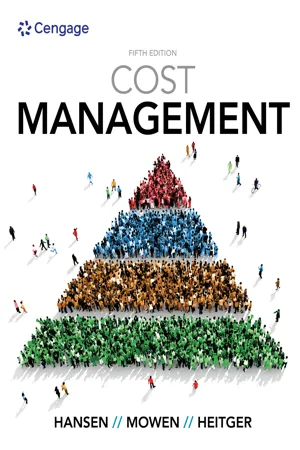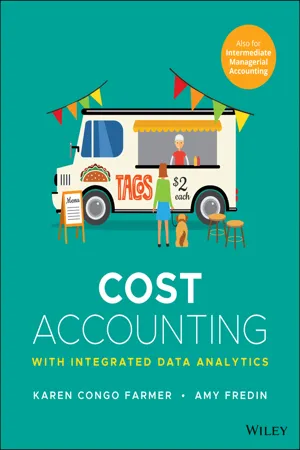Technology & Engineering
Activity Based Costing
Activity Based Costing (ABC) is a cost accounting method that identifies and assigns costs to specific activities in an organization. It provides a more accurate way to allocate costs by linking them to the actual activities that drive those costs. By understanding the cost drivers, ABC helps in making informed decisions about resource allocation and process improvements.
Written by Perlego with AI-assistance
Related key terms
1 of 5
12 Key excerpts on "Activity Based Costing"
- eBook - PDF
Managerial Accounting
Tools for Business Decision Making
- Jerry J. Weygandt, Paul D. Kimmel, Jill E. Mitchell(Authors)
- 2020(Publication Date)
- Wiley(Publisher)
The limitations of ABC are (1) the higher analysis and measurement costs that accompany multiple activity centers and cost drivers, and (2) the necessity still to assign some costs arbitrarily. 4 Apply activity-based costing to service industries. The overall objective of using ABC in service industries is no different than for manufacturing industries—that is, improved costing of ser- vices performed (by job, service, contract, or customer). The general approach to costing is the same: analyze operations, identify activities, accumulate overhead costs by activity cost pools, and identify and use cost drivers to assign the cost pools to the services. *5 Explain just-in-time (JIT) processing. JIT is a processing system dedicated to having on hand the right ma- terials and products just at the time they are needed, thereby reducing the amount of inventory and the time inventory is held. One of the principal accounting effects is that one account, Raw and In-Process Inventory, replaces both the raw materials and work in process inven- tory accounts. Glossary Review Activity Any event, action, transaction, or work sequence that incurs costs when producing a product or performing a service. (p. 4-5). Activity-based costing (ABC) A costing system that allocates over- head to multiple activity cost pools and assigns the activity cost pools to products or services by means of cost drivers. (p. 4-5). Activity-based management (ABM) Extends ABC from product costing to a comprehensive management tool that focuses on reducing costs and improving processes and decision-making. (p. 4-15). Activity cost pool The overhead cost attributed to a distinct type of activity or related activities. (p. 4-5). 4-28 CHAPTER 4 Activity-Based Costing 1. (LO 1) Activity-based costing (ABC): a. can be used only in a process cost system. b. focuses on units of production. c. focuses on activities needed to produce a good or perform a service. - eBook - PDF
- Don Hansen, Maryanne Mowen, Dan Heitger, , Don Hansen, Maryanne Mowen, Dan Heitger(Authors)
- 2021(Publication Date)
- Cengage Learning EMEA(Publisher)
Copyright 2022 Cengage Learning. All Rights Reserved. May not be copied, scanned, or duplicated, in whole or in part. Due to electronic rights, some third party content may be suppressed from the eBook and/or eChapter(s). Editorial review has deemed that any suppressed content does not materially affect the overall learning experience. Cengage Learning reserves the right to remove additional content at any time if subsequent rights restrictions require it. Chapter 4 Activity-Based Costing 169 product-costing accuracy, which can significantly improve decision making. Additionally, this large pool of fixed overhead costs is no longer so mysterious. Knowing the underlying behavior of many of these costs allows managers to exert more control over the activities that cause the costs. It also allows managers to identify which of the activities add value and which do not. Value analysis is the heart of activity-based management and is the basis for continuous improvement. Activity-based management and continuous improvement are explored in later chapters. Reducing the Size and Complexity of an ABC System As should be evident from the discussion up to this point, ABC systems are expensive to create and implement, complex to operate, and difficult to modify or update. You may wish to review Exhibit 4.6, which listed six steps for the process of creating, implementing, and operating an ABC system. The first three steps correspond to the first stage of ABC (Stage 1), and the last three steps correspond to the second stage of ABC (Stage 2). Stage 1 requires time-consuming and costly interviewing and surveying with the objective of identifying and classifying activities and then determining the cost of each activity. This Stage 1 process produces results that are subjective and difficult to validate. Stage 2 requires an activity rate for each activity. An organi-zation may have hundreds of different activities and, thus, hundreds of activity rates. - eBook - PDF
Cost Management
Measuring, Monitoring, and Motivating Performance
- Leslie G. Eldenburg, Susan K. Wolcott, Liang-Hsuan Chen, Gail Cook(Authors)
- 2016(Publication Date)
- Wiley(Publisher)
320 C H A P T E R 7 Activity-Based Costing and Management regular and premium doors, the flow of resources was more accurately reflected, and the allocated costs were different from the job costing system because more cost pools were used, and each cost pool was allocated using a cost driver that better reflected the use of the resources in the activity cost pool. Costs of an ABC System. Many costs are associated with designing and using an ABC system, including the following: ▶ System design costs, such as costs of employee time and consulting fees ▶ Accounting and information system modifications needed to gather and report activ- ity and cost driver information ▶ Employee training to use the ABC system effectively Sometimes, the cost of developing ABC information is low, especially in cases where the activity cost is readily available and the number of times the activity is performed can easily be tracked. Suppose the activity is inspection of units. The cost consists of the salary and fringe benefits of the inspector and the number of units being inspected. Identifying salary costs in an accounting system is easy, and fringe benefit costs can be estimated. The number of units produced should be readily available from production records, and the capacity of the inspection area can be easily estimated. Thus, developing an activity-based cost for inspection may be as simple as dividing the salary-related costs by a chosen measure of unit volume. Other times, ABC information is more costly to develop. Suppose the activity is the setup process. This process often includes labour, supplies, and other resources. Because cost tracing is one of the components of cost assignment under ABC, it takes time and analy- sis to identify costs that can be traced and those that should be allocated. In addition, data for the cost driver, such as the number of setups, must be tracked. - eBook - PDF
Management Accounting
International Syllabus
- Carsten Berkau(Author)
- 2023(Publication Date)
- UVK Verlag(Publisher)
making changes of the business opera- tions and adjust budgeted costs for processes and business activities. This leads to monitoring which is similar but different to standard costing. We apply the same case TORQUAY Ltd. for activity based management (ABM). The part ABM has been placed to the online materials. In the second section of this chapter, we discuss the concept of target cost- ing. We stick to be case study TORQUAY Ltd. and design the busi- ness class service based on a target costing model. 21.2. Learning Objectives Activity Based Costing (ABC) became a popular Management Accounting in- strument during the last decades. It fo- cusses on business activities and pro- cess chains. In this chapter, you learn how ABC as- signs costs to business processes, which are sequences of business activ- ities across departmental borders. You will understand that in an ABC system, costs are accounted for on the average principle and allocated by cost drivers. After studying this chapter, you know how ABC works and you can distin- guish it from a partial costing paired with contribution margin Accounting. You can discuss and decide about the right cost Accounting system for the management of fixed costs. Berkau: Management Accounting 7e 21-300 21.3. Background for ABC ABC apportions fixed costs to busi- ness activities. The allocation of over- heads breaches with the cost-by-cause principle as it follows the average prin- ciple. The cost drivers in use do not allow a fair cost allocation. A cost driver is a unit which measures activity perfor- mances, and which influences the re- source allocation thereto. Allocations based cost drivers only divide fixed costs. The main difference between a reference unit (traditional cost Ac- counting) and a cost driver (ABC) is that a cost driver is not proportional depending on the output. Cost alloca- tions per average lead to volatile unit costs. If the cost driver is low, cost rates become very high. - eBook - PDF
- Carsten Berkau, Keabetswe Sylvia Berkau, Mohd Ridzuan Darun(Authors)
- 2021(Publication Date)
- UVK Verlag(Publisher)
Berkau/Darun: Management Accounting (2 nd Asia Edition) 21-360 21. Activity Based Costing 21.1. What is in the Chapter? In this chapter about Activity Based Costing, you learn about a modern Controlling approach based on busi-ness processes. Activity Based Costing is an alternative to multiple-level con-tribution margin accounting. We rec-ommend the application of Activity Based Costing, if the CMA does not work, meaning, if fixed costs cannot be allocated to cost objects or groups thereof. In those cases, the contribu-tion margins remain small, and a huge block of fixed costs remains. Why do we prefer CMA? It is because of an ac-tivity based costing is based on the av-erage principle for cost allocation. This is what we only accept after a cost al-location following the cost-by-cause principle failed. Here, we introduce the concept of an Activity Based Costing system (ABC) and discuss its application for the air-line company TORQUAY Ltd. We fo-cus on their fixed costs in the Ticket-ing, Re-scheduling and Advertising de-partments. To point out the concep-tual differences, we compare the costs allocations made by ABC to those re-sulting from a traditional cost Ac-counting system. Further, we discuss activity based management which is about making changes of the business operations and budgeting costs for processes and business activities. We apply the same case TORQUAY Ltd. for activity based management (ABM). 21.2. Learning Objectives Activity Based Costing (ABC) became a popular Management Accounting in-strument during the last decades. It is linked to business reengineering. It is based on business activities and pro-cess chains. In this chapter you learn how ABC as-signs costs to business processes, which are sequences of business activ-ities crossing departmental borders. You will understand that in an ABC system, costs are allocated by cost driv-ers. A cost driver is a factor that deter-mines the consumption of fixed costs. - eBook - PDF
Cost Accounting
With Integrated Data Analytics
- Karen Congo Farmer, Amy Fredin(Authors)
- 2022(Publication Date)
- Wiley(Publisher)
• Using ABC results in a better understanding of the critical activities within a business, which leads to identification of non-value-added activities, which leads to increased efficiency, and so on. • Time-driven activity-based costing (TDABC), an alternative to standard ABC, determines how much capacity is available for each activity, measured in time, with a cost applied. – The cost for supplying an activity, multiplied by the number of minutes it takes to supply one unit of each transaction, yields the cost driver rate per activity, which is multiplied by the quantity of that activity undertaken to determine the cost allocated to the activity. – Idle time is usually inevitable, and it may be a sign of excess capac- ity. TDABC can help a company measure and cost this excess capacity so it can decide what, if anything, to do about it. - eBook - PDF
Managerial Accounting
Tools for Business Decision-Making
- Jerry J. Weygandt, Paul D. Kimmel, Donald E. Kieso, Ibrahim M. Aly(Authors)
- 2018(Publication Date)
- Wiley(Publisher)
Applying an Activity-Based Costing System 183 Management Insight ABC Evaluated Surveys of companies often show ABC usage of approximately 50%. Yet, in recent years, articles about ABC have expressed mixed opinions regarding its usefulness. To evaluate ABC practices and user satisfaction with ABC, a survey was conducted of 348 com- panies worldwide. Some of the interesting findings included the following: ABC methods are widely used across the entire value chain, rather than being primarily used to allocate production- specific costs; only 25% of non-ABC companies think they are accurately tracing the costs of activities, while 70% of ABC com- panies think their company does this well; and respondents felt that ABC provides greater support for financial, operational, and strategic decisions. More than 87% of respondents said that their ideal costing system would include some form of ABC. Since this significantly exceeds the 50% of the respondents actually using it, ABC usage may well increase in the future. Source: William Stratton, Denis Desroches, Raef Lawson, and Toby Hatch, “Activity-Based Costing: Is It Still Relevant?” Management Accounting Quarterly (Spring 2009), pp. 31–39. What might explain why so many companies say that ideally they would use ABC, but they haven’t adopted it yet? Companies that move from traditional costing to ABC often have similar experiences as ABC shifts costs from high-volume products to low-volume products. This shift occurs because low-volume products are often more customized and require more special handling. Thus, low-volume products are frequently responsible for more overhead costs. In addition, ABC recognizes products’ use of resources, which also increases the accuracy of product costs. DO IT! 2 Apply ABC to a Manufacturer Casey Company has five activity cost pools and two products. It estimates it will produce 200,000 units of its automobile scissors jack, and 80,000 units of its truck hydraulic jack. - No longer available |Learn more
- Don Hansen, Maryanne Mowen(Authors)
- 2017(Publication Date)
- Cengage Learning EMEA(Publisher)
Collecting engineering data 6. Handling wafer lots 7. Inserting dies 8. Providing utilities 9. Providing space 10. Purchasing materials 11. Receiving materials 12. Paying for materials Chapter 4 Activity-Based Costing 159 difference between the two types of activities facilitates product costing. Exhibit 4.5 indicates that activities consume resources. Thus, in the fi rst stage of activity-based cost-ing, the cost of resources is assigned to activities. Exhibit 4.5 also reveals that products consume activities — but only primary activities. Thus, before assigning the costs of pri-mary activities to products, the costs of the secondary activities consumed by primary activities must be assigned to the primary activities. Many other useful activity classi fi -cations exist. For example, activities can be classi fi ed as value-added or non-value-added (de fi ned and discussed in detail in Chapter 12) and as quality-related or as environmental (discussed in Chapter 14). In designing an activity costing system, the desired attributes and essential classi fi cations need to be characterized up front so that the necessary data can be collected for the activity dictionary. Gathering the Necessary Data Interviews, questionnaires, surveys, and observa-tion are means of gathering data for an ABC system. Interviews with managers or other knowledgeable representatives of functional departments are perhaps the most common approach for gathering the needed information. Interview questions can be used to iden-tify activities and activity attributes needed for costing or other managerial purposes. The information derived from interview questions serves as the basis for constructing an activity dictionary and provides data helpful for assigning resource costs to individual activities. In structuring an interview, the questions should reveal certain key attributes. - eBook - PDF
Managerial Accounting
Tools for Business Decision-Making
- Jerry J. Weygandt, Paul D. Kimmel, Ibrahim M. Aly(Authors)
- 2020(Publication Date)
- Wiley(Publisher)
If managers are better able to understand and control their operations using ABC, and the costs are not prohibitive, the use of ABC would be beneficial. How can ABC help managers manage the business? Activities classified as value- added or non–value-added The activity analysis flowchart extended to identify each activity as value-added or non–value-added The flowchart should motivate managers to minimize non– value-added activities. Managers should better understand the relationship between activities and the resources they consume. Glossary Review Activity Any event, action, transaction, or work sequence that causes a cost to be incurred in producing a product or providing a service. (p. 5-5) Activity-based costing (ABC) An overhead cost allocation system that allocates overhead to multiple activity cost pools and assigns the activity cost pools to products or services by using cost drivers that represent the activities used. (p. 5-5) Activity-based management (ABM) An extension of ABC from a product costing system to a management function that focuses on reduc- ing costs and improving processes and decision-making. (p. 5-14) Activity cost pool The overhead cost allocated to a distinct type of activ- ity or related activities. (p. 5-5) Batch-level activities Activities performed for each batch of products. (p. 5-14) Cost driver Any factor or activity that has a direct cause–effect relation- ship with the resources consumed. In ABC, companies use cost drivers to assign activity cost pools to products or services. (p. 5-5) Facility-level activities Activities required to support or sustain an entire production process that are not dependent on the number of prod- ucts, batches, or units produced. (p. 5-14) Non–value-added activities Non-essential activities that add cost to, or increase the time spent on, a product or service without increasing its market value. (p. 5-15) Product-level activities Activities performed for and identifiable with an entire product line. - eBook - PDF
- Jerry J. Weygandt, Paul D. Kimmel, Jill E. Mitchell(Authors)
- 2020(Publication Date)
- Wiley(Publisher)
(p. 17-23). Non–value-added activity A nonessential activity that, if eliminated, would not reduce the perceived value of a company’s product or service. (p. 17-16). Product-level activities Activities performed in support of an entire product line but not always performed every time a new unit or batch of products is produced. (p. 17-15). Unit-level activities Activities performed for each unit of production. (p. 17-15). Value-added activity An essential activity that increases the perceived value of a product or service to a customer. (p. 17-16). * 3 Explain the benefits and limitations of activity-based costing. Features of ABC that make it a more accurate product costing system include (1) the increased number of cost pools used to assign overhead (including use of the activity-level hierarchy), (2) the enhanced con- trol over overhead costs (including identification of non–value-added activities), and (3) the better management decisions it makes possible. The limitations of ABC are (1) the higher analysis and measurement costs that accompany multiple activity centers and cost drivers, and (2) the necessity still to assign some costs arbitrarily. 4 Apply activity-based costing to service industries. The overall objective of using ABC in service industries is no different than for manufacturing industries—that is, improved costing of ser- vices performed (by job, service, contract, or customer). The general approach to costing is the same: analyze operations, identify activities, accumulate overhead costs by activity cost pools, and identify and use cost drivers to assign the cost pools to the services. *5 Explain just-in-time (JIT) processing. JIT is a processing system dedicated to having on hand the right ma- terials and products just at the time they are needed, thereby reducing the amount of inventory and the time inventory is held. - eBook - PDF
- Jerry J. Weygandt, Paul D. Kimmel, Donald E. Kieso(Authors)
- 2018(Publication Date)
- Wiley(Publisher)
c. In today’s increasingly automated environment, direct labor is never an appropriate basis for allocating costs to products. d. A cost driver is any factor or activity that has a direct cause-effect relationship with resources consumed. e. Activity-based costing segregates overhead into various cost pools in an effort to provide more accurate cost information. DO IT! 17.2 (LO 2) Flynn Industries has three activity cost pools and two products. It estimates production 3,000 units of Product BC113 and 1,500 of Product AD908. Having identified its activity cost pools and the cost drivers for each pool, Flynn accumulated the following data relative to those activity cost pools and cost drivers. Identify characteristics of traditional and ABC systems. Compute activity-based overhead rates and assign overhead using ABC. Estimated Use of Annual Overhead Data Cost Drivers per Product Estimated Estimated Use of Cost Product Product Activity Cost Pools Cost Drivers Overhead Drivers per Activity BC113 AD908 Machine setup Setups $ 16,000 40 25 15 Machining Machine hours 110,000 5,000 1,000 4,000 Packing Orders 30,000 500 150 350 DO IT! Exercises Using the above data, do the following: a. Prepare a schedule showing the computations of the activity-based overhead rates per cost driver. b. Prepare a schedule assigning each activity’s overhead cost to the two products. c. Compute the overhead cost per unit for each product. (Round to nearest cent.) d. Comment on the comparative overhead cost per product. DO IT! 17.3 (LO 3) Adamson Company manufactures four lines of garden tools. As a result of an activity analysis, the accounting department has identified eight activity cost pools. Each of the product lines is produced in large batches, with the whole plant devoted to one product at a time. Classify each of the following activities or costs as either unit-level, batch level, product-level, or facility-level. a. Machining parts. e. Assembling parts. b. Product design. - eBook - PDF
- Charles E. Davis, Elizabeth Davis(Authors)
- 2020(Publication Date)
- Wiley(Publisher)
Although the total amount of allocated overhead differs between the two methods, we can still compare the percentage of overhead allocated to each product. Notice where the big differences occur in Exhibit 7.9. Under the traditional costing method, pants were allo- cated 53.23% of manufacturing overhead, yet under activity-based costing, pants received just 33.03% of manufacturing overhead. The other major difference between the two methods was for award jackets, which were allocated 31.33% of total overhead under the traditional method and 50.71% under activity-based costing. What caused the differences in the relative amount of manufacturing overhead allocated under the two methods to pants, a high-volume product, and jackets, a low-volume prod- uct? One obvious cause is the costs associated with the chenille machine. Under traditional costing, these costs were shared by all three products. However, under activity-based costing, these costs are traced directly to jackets, reducing the amount of overhead allocated to pants and increasing the amount of overhead allocated to jackets. A second cause of the difference in costs results from the cutting operation. Jacket produc- tion required more cutting than pant production, even though C&C produced only one-tenth the number of jackets as pants. This shift in cost from a high-volume to a low-volume prod- uct is quite common in newly implemented activity-based costing systems. That is because low-volume products, like jackets, tend to use as many product-level activities as other prod- ucts, while generating as many or more batch-level activities. Reality Check ABC isn’t just for manufacturing While most people probably think of activity-based costing (ABC) as a tool to better determine product costs in a manu- facturing setting, its applicability goes far beyond the factory walls.
Index pages curate the most relevant extracts from our library of academic textbooks. They’ve been created using an in-house natural language model (NLM), each adding context and meaning to key research topics.











